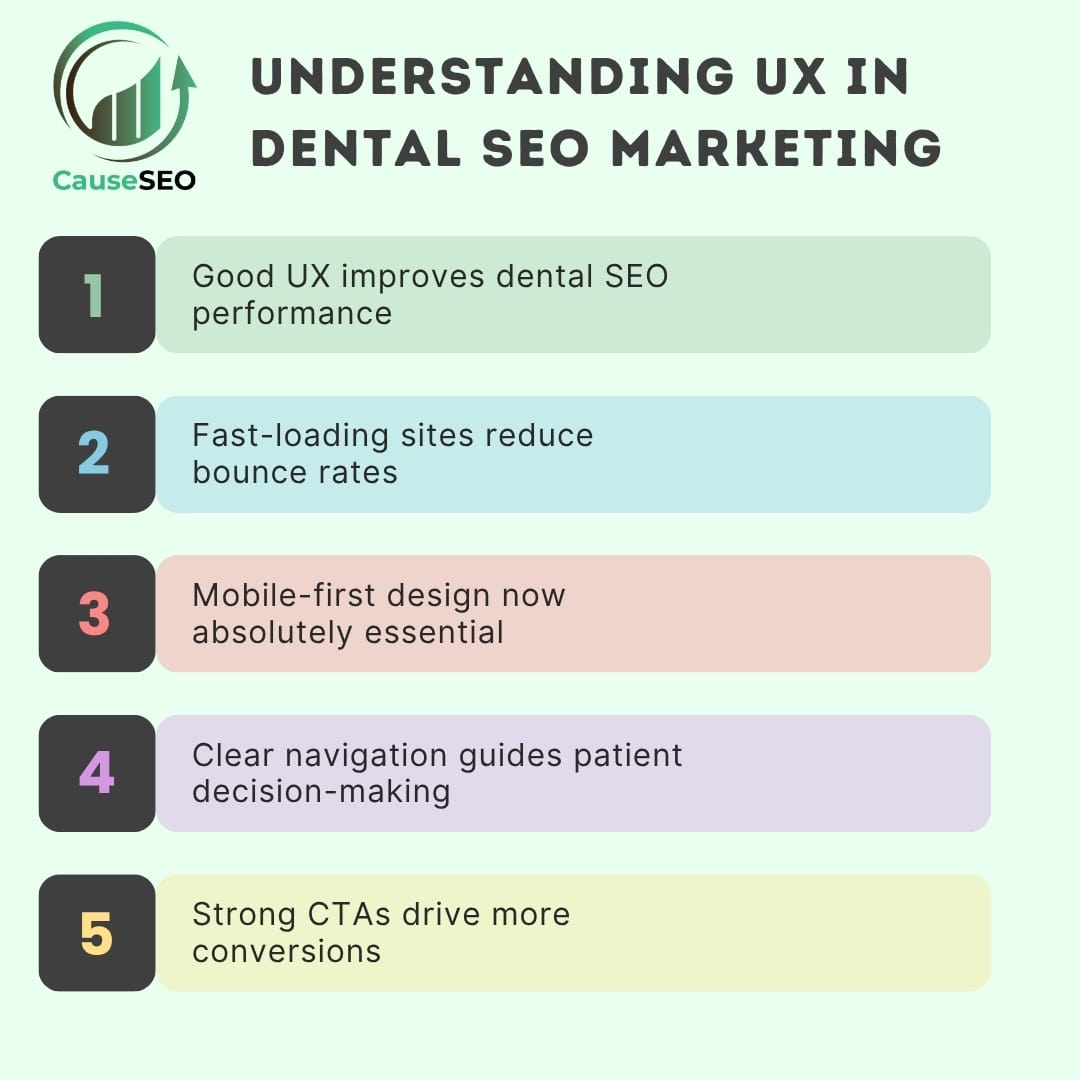Understanding UX in dental SEO marketing is essential for dentists aiming to attract and convert more patients online. User experience (UX) plays a major role in how your dental website performs in search—and how effectively it turns visitors into patients. In simple terms, UX is how people interact with your site: Is it easy to use? Does it load quickly? Can someone find what they’re looking for without frustration?
For dental SEO, UX directly impacts rankings, bounce rates, time on site, and conversions. A site that feels smooth, modern, and helpful makes both Google and your patients happy.
In this guide, we’ll look at the UX factors dental SEO experts focus on, how UX ties into your SEO strategy, and what tools can help you improve both performance and patient experience.
What Is UX and Its Role in Dental SEO?
UX Defined
UX stands for “user experience.” It’s the quality of a visitor’s interaction with your website. For dental practices, this includes:
- Site speed
- Navigation
- Mobile usability
- Readability
- Ease of booking or calling
The goal is to make every visitor’s journey simple, smooth, and helpful—so they feel confident booking an appointment.

Why Google Cares About UX
Google wants to rank websites that deliver value. That includes ease of use, especially on mobile devices. Google’s algorithm now uses Core Web Vitals and mobile-first indexing as ranking factors. That means your site’s design, speed, and functionality directly affect where you appear in search results.
UX Elements Dental SEO Specialists Optimize
Site Speed and Core Web Vitals
A slow site leads to high bounce rates. Most visitors won’t wait more than a few seconds. Google’s Core Web Vitals measure things like:
- How fast your page loads
- How quickly it becomes interactive
- How stable the layout is as it loads
Tools like Google PageSpeed Insights or Lighthouse help identify what’s slowing your site down. Fixing those issues improves both UX and SEO.
Mobile Optimization
Most dental searches happen on phones. If your site isn’t mobile-friendly, it’s not competitive. That means:
- Buttons should be easy to tap
- Forms should be short and simple
- Text must be readable without zooming
Dental local SEO relies heavily on mobile users looking for “dentist near me”—if your mobile UX is poor, you’ll lose those leads.
Simple and Clear Navigation
Visitors should be able to find what they need within one or two clicks. Use straightforward menu paths like:
Home > Services > Dental Implants
Include visible calls-to-action (CTAs) like “Call Now,” “Book Online,” or “Get Directions” in places users expect.
Content Layout and Readability
Long paragraphs and technical jargon don’t work. Instead:
- Use headers to break up sections
- Write in short paragraphs
- Use bullet points for key info
- Add helpful visuals where relevant
Your site should feel like a conversation, not a textbook.
Conversion-Focused Design
Make it easy for patients to act. That means placing:
- Phone numbers and forms above the fold
- “Schedule Now” buttons near every service section
- Navigation links to the contact page on every screen
If people can’t find a way to reach you fast, they’ll leave.
Visual Trust Signals
Patients are more likely to trust a site that feels real and personal. Include:
- Staff photos
- Video testimonials
- Doctor bios
- Real patient reviews
- Industry credentials or badges
These increase time on site and reduce hesitation—two important UX and SEO metrics.

How UX and SEO Work Together to Attract and Convert Patients
Lower Bounce Rate, Higher Engagement
If someone lands on your page and leaves right away, Google sees that as a bad sign. A well-designed, easy-to-navigate site keeps people around longer—and that helps rankings.
Good UX helps people quickly find what they came for. Whether that’s service info, directions, or a way to book, meeting those needs increases engagement and trust.
Higher Local Rankings and Patient Trust
In local dental SEO, engagement is a signal of relevance. When people stay on your site and interact, it sends a message that your practice is a good result for local queries.
That trust leads to more bookings—and more reviews and mentions, which feed back into your local rankings.
Common UX Mistakes That Hurt Dental SEO
Slow Page Load Times
Large images, clunky code, or too many scripts can slow down your site. This especially hurts on mobile, where every second counts.
Confusing or Overcrowded Navigation
Too many menu items or dropdowns overwhelm visitors. Keep your top menu simple, with key pages like Services, About, and Contact.
Weak or Missing CTAs
If there’s no clear next step, people won’t take one. Every page should offer a way to contact or convert.
Cluttered Layout or Outdated Design
If your site looks like it hasn’t been updated in years, people may assume your practice is outdated too. Clean, modern design inspires trust.
Tools Used by Dental SEO Experts to Measure and Improve UX
Analytics and Heatmaps
- Google Analytics: track bounce rate, time on page, and page flow.
- Hotjar / Microsoft Clarity: visualize how users move and click across your pages.
These tools help you spot where users get lost—or where they’re most engaged.
UX and SEO Audits
- Google Search Console: shows indexing issues and performance drops.
- Lighthouse & GTmetrix: scan for speed, layout shifts, and accessibility problems.
Dental SEO experts use these tools to find UX bottlenecks and recommend fixes.

FAQs – UX and Dental SEO
What is UX in dental SEO?
UX, or user experience, is how easy and enjoyable it is for visitors to use your dental website. It affects how long they stay, whether they convert, and how Google ranks your pages.
How does UX impact Google rankings?
A positive UX improves engagement metrics (like time on site and low bounce rate), which Google uses as indirect signals to rank your site higher.
What are Core Web Vitals and why do they matter?
Core Web Vitals are Google’s measures of page speed, responsiveness, and stability. They help Google decide if your site provides a smooth experience—especially on mobile.
How can I make my dental website more user-friendly?
Start by simplifying your layout, speeding up load times, making mobile design a priority, and ensuring every page has a clear CTA.
Should I redesign my website for better SEO?
If your site is outdated, slow, or hard to use on mobile, a redesign can significantly improve both SEO and patient conversions.
Do UX improvements help with patient conversions?
Yes. Good UX makes it easier for visitors to take action—whether that’s calling, filling out a form, or booking online. That leads to more new patients.
Conclusion
Good UX isn’t optional—it’s foundational. If your website is hard to use, slow to load, or difficult to navigate, both patients and search engines will move on.
Dental SEO isn’t just about keywords or links—it’s about how people experience your site. That experience affects everything from your Google ranking to your conversion rate.
Start with a user-focused audit or connect with a dental SEO expert at Cause SEO to upgrade your design, performance, and patient experience.

